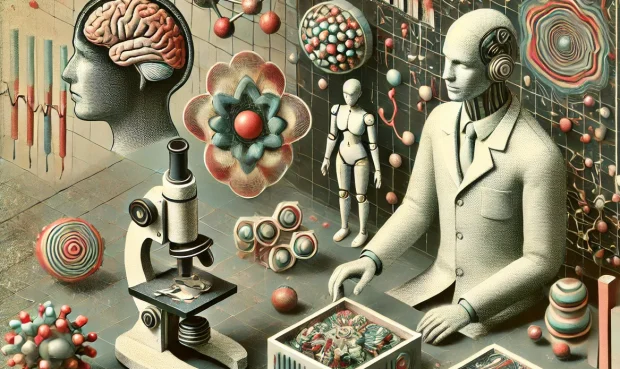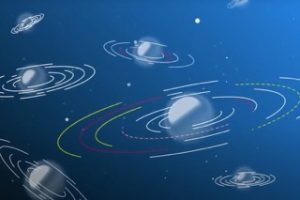What Will Happen If a Giant Meteorite Hits the Ear...
Will it destroy everything?

The Curiosity Rover is NASA’s most recent Mars rover mission. It had been under development since around 2003, launched in 2011, got to Mars in 2012, and will be on the surface for four years as of August 2016. It’s part of a program of NASA Mars missions for the past couple of decades, and the specific place that the Mars Science Laboratory fits in is to understand whether Mars was ever a habitable planet. Specifically, whether the local region where we landed ever offered conditions suitable for life. We’re following missions that found liquid water on Mars, and we’re preceding missions that will look for life directly, look for actual biological evidence of life, whether dead or alive. But we’re in that middle ground where we’re simply asking: were the geologic conditions, the environment, the climate, the nutrients, and water, were all the different elements that life required to present, ever, at the same place and time?
So far, we’ve found that the place where we landed, Gale Crater, which was carefully selected after a 6-year process of studying Mars from orbital data, was, at one point, a habitable environment, an environment that was conducive to supporting life. After we landed, one of the first discoveries we made was evidence of flowing liquid water in the past. The evidence is that we found pebbles that were part of an ancient streambed. So that was kind of amazing – we were driving right through an ancient river bed where now the evidence left behind was rounded pebbles that were incorporated into bedrock.
Just from the size of those pebbles and their roundedness, it was possible to tell that a stream of water, from a few inches to a few feet deep, flowed for quite a long distance to carry those pebbles and round them. We followed that a little further and got to an area where we were hypothesizing that there was an ancient lake bed, where water would have actually pooled and sediment in the water would have settled down.

One of the things that Curiosity has that no mission has had before is a drill that can collect samples of rocks. It then can study the powder that’s gained from those rocks in onboard laboratories. So, just like the Mars Exploration Rovers Spirit and Opportunity, Curiosity, of course, has cameras; it has an arm that goes out and puts sensors on the rocks, including a microscopic camera. But the thing it can do that those rovers couldn’t drill into rocks and get powder from those rocks delivered into the rover itself, where it has two big geochemical laboratories, one of which is there to detect what minerals are present in the rocks, and the other is there to figure out what the rock chemistry is, and whether there are any organic molecules in those rocks.
So we drilled into the place where we thought there might have been an ancient lake, a place called Yellowknife Bay, and we gathered rock powder and analyzed it, and then with the mineralogy instrument, CheMin, we found that it had about 20% clay minerals. This wasn’t obvious from orbit; this was a discovery we could only make from the ground and with our laboratory.
Clay minerals indicate that water had interacted with the basic basaltic rock on Mars for a long enough time and in a neutral pH environment – a non-acidic environment – in order to form those clay minerals. So that was one of our strongest pieces of evidence for a habitable environment, the fact that neutral pH water was there interacting with rock for a long time in this lake. And the rock itself was very fine-grained, just like you’d expect if sediment in a lake environment had settled down and formed mud at the bottom of the lake, and then that mud had turned to rock.
Then there is a longer checklist of other things that make a habitable environment, including nutrients for life. We found all the key chemical elements that life requires: carbon, hydrogen, nitrogen, oxygen, phosphorus, and sulfur – C, H, N, O, P, S – and then, later on, through a more thorough analysis of the same material, we found that nitrogen was in the form of nitrates. So not only were nitrogen and oxygen present as chemical elements but also in the form of nitrate molecules, which makes the nitrogen accessible to being used by life.
When N2 is present as nitrogen gas in the atmosphere, it’s a very strong chemical bond, and life can’t make use of it easily. However, when you “fix” the nitrogen and turn it into nitrate, that’s what makes it accessible to life. And it wasn’t clear that Mars had a process like Earth does to form nitrate, but we found that it had a nitrogen cycle at one point and was able to produce nitrogen in this form.
We also found organic molecules in that same Yellowknife Bay rock. These are simple organic molecules, maybe because they always were small organic molecules, but they could also be simply because they are 3 billion years old, at least, and organic molecules can degrade over time due to the harsh, oxidizing surface environment and subject to things like ultraviolet light and high-energy radiation. So the fact that we found simple organics at least indicates that hydrocarbons were there. But, it also could indicate that there were even more complex organics in the past.
It was an amazing, comprehensive set of measurements and indicators of habitability in this one region, and that was all in the first year of the mission. At first, it was only a two-year mission, so it wasn’t clear how quickly it would be able to address the primary goal of seeing whether there was a habitable environment. Our goal was to assess whether Mars was ever habitable, and the answer could have been “yes” or “no”. Not only were we able to find a place where we could do that assessment, this ancient lakebed, but then the answer turned out to be “yes”, which makes it even better.
When NASA designs its planetary missions, there first is a set of science objectives, and then the spacecraft and payload are engineered to be able to last long enough to fulfill those science objectives. For example, if NASA had designed Curiosity to be a 90-day mission from the start and had designed all the parts to last 90 days, that’s not enough to assess habitability, take rock samples, and put them in the labs. That wouldn’t work. So two years was thought to be enough time to make a comprehensive assessment of habitability after roving to several different sites.
As of the summer of 2016, we are nearly at the end of our first two-year extension. And in July 2016, we were approved for our second two-year extension. So NASA and other scientists who reviewed our progress seem to appreciate the work that Curiosity and the mission’s science team are doing.
Curiosity celebrates, too. In fact, for its first birthday, we had it sing “Happy Birthday” to itself. There are a couple of instruments that make noises as they operate, and one of the laboratories, SAM, the Sample Analysis at Mars laboratory, makes noise. The engineers who run SAM figured out they could actually change the frequency of that noise to make a melody. So if you were standing next to the rover, you would have actually heard it singing “Happy Birthday” to itself.
So far the good news is that the rover and all the instruments are doing incredibly well, even after almost two years beyond their designed life. And part of that is just because when we build something to last two years, we test it to last many times that, just to really make sure it works for those two years. So a lot of the parts were tested for six years, for example. And we left margin in other systems so that after two years, they still have a good amount of expected life left in them.
So, so far all those things are happening well. We do have some issues, some of which are due to age, like the wear on the wheels – that’s one of our largest engineering concerns. Fortunately, it’s one that’s manageable. The wheels are deteriorating faster than we had hoped, but now we’ve been able to change the way we drive and more carefully avoid certain kinds of rocks that we’ve found to cause damage and extend the life of the wheels.
We also have some electrical issues, none of which have affected the mission much yet, but nevertheless are a cause for concern if they get any worse. There have been two different electrical shorts in our drill and in one of the parts that process the powder that the drill acquires. The drill itself has one electrical short that comes and goes, and then a processing system for the material has another one. We just monitor those and see if they are getting any worse, but at this point, there isn’t anything that’s actually a known factor that will limit us in the next few years from being just as productive as we are now.
The one thing, in terms of lifetime, that is very predictable is the degradation of our power source. We don’t have solar panels on Curiosity, we have a Radioisotope Thermoelectric Generator, which uses naturally radioactive plutonium dioxide to generate heat, and then that heat is converted to electricity, and we store that in a battery and use it to power the instruments in the rover. That choice was made because, as we talked about before, when you design something for 90 days, you can bank on solar panels even if dust is settling out and covering them because, in 90 days, that won’t be a factor. But when you design a mission for two years, that becomes too risky to count on, and the Gale Crater is actually a very dusty place.
So we put a nuclear power source on it, and the upside is that you don’t have to depend on the sun anymore. The downside is that plutonium decays very predictably over time, and other parts in the power source as well, so we lose about 4 to 5 % of our power output per year. Now, after nearly four on the surface, we’ve already lost 15-20% of our power, and then looking at another three or four years, we’ll lose another 15-20%. And at some point, you have to start dialing back on how actively you use all of the instruments and how far you drive every day because you are just not generating enough energy. We think the next three to four years will look pretty similar to the last if we’re lucky and nothing catastrophically breaks, though there’s always that chance. But after about three to four years, we’ll have to start slowing down quite a bit.
Of course, we can’t fix anything on Curiosity, in the sense of a human going to Mars and putting on a new wheel; that’s impossible. But the rover is built to be as reliable as possible, given the importance of the mission and the budget we had to work with. This is what NASA calls a “flagship” mission, which means it is a key mission within the NASA Mars Exploration Program, and it was given a budget to reflect that. This allowed us to make the rover more reliable than perhaps other missions that are smaller or have a less critical role to play.

Accordingly, we actually have a lot of redundancy on the rover. We have two computers and a lot of the electronics are duplicated. So, for example, we actually had one instance where, early in the mission, on Sol 200, we lost part of our memory storage on what we were using as the main computer at the time. And if we only had that one computer, we’d now be operating with half the memory. Fortunately, we could just start using the backup computer, and we’ve been on that computer since the 200th day of the mission. So redundancy has already paid off, and it will continue to pay off as parts might degrade in the future.
There’s also a ton of fault protection. All spacecraft have it, and the Curiosity mission has that much more of it because it’s such a complex mission. That’s usually software, so some large fraction of all the computer code that’s sitting on Curiosity is just there to check all the other code that’s running and to check the commands that the humans on Earth are giving it, and to catch errors induced by radiation from the sun and from galactic cosmic rays that can cause little errors in digital electronics. There’s just a ton of that going on all the time.
So while we can’t “fix” anything, per se, we have redundancy, we have fault protection, and we have those ingenious NASA workarounds that you see in the movies. We have to do some of those too, where something has an issue, and then a great team of engineers here at JPL will send the scientists out of the room, so to speak, get together and solve the problem.
The laboratories are Curiosity’s main new capabilities in terms of science. The things that Curiosity had to develop almost from scratch because they didn’t exist on any previous mission would be the ability to acquire samples of rock and to analyze those samples in laboratories. The Viking lander scooped up the soil, and so did the Phoenix lander, but we actually wanted to get not the soil, but the interior of the rocks, because, just like on Earth, the ancient geology is recorded in the rocks, not the soil next to the rocks. So we needed to drill into those rocks. And, of course, operating a big jackhammer drill in space without ever being able to lubricate or fix it was a huge engineering development.
And then, on the science side, one of the scientific institutions around the world that contributed to our payload built the mineralogy instrument, which uses X-rays to shine through crystalline rock powder. The X-rays diffract and form a kind of rainbow pattern and give you a definitive detection of what minerals are in the rocks. X-ray diffraction is a very common technique in any geology department at a university on Earth, but had never been flown in space before.
And even more complex than that one is the second laboratory, which is an entire wet chemistry laboratory where you also use techniques that are in many chemistry laboratories on Earth, but that usually fill up an entire room. You put a little rock powder in a crucible, heat up that powder to 900 degrees centigrade, and it slowly breaks down as you continue to heat it up. Gases come off, and you analyze those gases in a mass spectrometer. And then you also have a gas chromatograph system to separate out the organic molecules that come out of that. So this is an entire chemistry laboratory in a box in the rover that you can never clean, you can never maintain, so it all has to be built to have a lot of self-cleaning, self-maintaining capability.
There are two upcoming NASA missions going on now. One of them is called InSight, which is a small, very focused mission that lands a fixed lander on Mars and deploys a seismology experiment. With the orbiters and the landers and the rovers we, of course, mostly look at the surface of Mars and the atmosphere, but we have little insight into the interior of Mars. There’s some ability to probe the interior by analyzing the detailed gravity around Mars from orbit, but really the interior has been a mystery.
One way you study the interior of Earth, of course, is through seismology. You’d love to have stations all around Mars to see how seismic waves reflect all over the place, but you have to start somewhere. So we have one lander with one seismometer, and it will use the natural seismic noise of Mars to make measurements. There may be some Mars quakes, and there are small impacts going on that can excite some seismic waves. It’ll be looking for all of that and give us our first look into the interior.
The next flagship mission that’s going to Mars doesn’t actually have a name yet; right now, it’s just called Mars 2020. It is a rover that looks a lot like Curiosity but will have the goal of collecting samples that will one day be returned to Earth, where state-of-the-art laboratories can study them. It also has a scientific payload that it will use itself before the samples get to Earth, which is designed to look for signatures of past life, and not just habitable conditions. So Mars 2020 will actually look for biosignatures – chemical, isotopic, and mineralogical signatures that life distinctly leaves behind.
We don’t completely know how we’ll get the samples back to Earth yet. It’s going to be a multi-stage process, so first, you’ll have the one rover that carefully collects the samples, which is the Mars 2020, which is a scientific mission in itself. It roves around, finds the best places to acquire these samples, and then stores the samples in vials that are then sealed and ready to come back to Earth. Then the mission’s over, and someone has to go get them.
So a to-still-be-designed follow-up mission, where nothing is firm yet, is another, perhaps small, rover that doesn’t have to be as capable scientifically. It might be something like Spirit or Opportunity, just capable of driving with an arm to collect these samples – what is sometimes called a “fetch” rover. So it fetches the samples, which could be located at the bottom of some canyon or up on a hill, and brings them to the rocket.
The reason you need the fetch rover is that you actually have to go retrieve these samples 2020 collected and then bring them to a rocket, which is waiting in a nice flat area. Then that rocket, a whole, intact, fueled rocket, also has to be delivered to Mars. You may be able to make fuel on the surface, that’s still to be determined, but nevertheless, you have to bring a rocket. And that rocket can’t be an Atlas V, the kind of rocket we use to launch Curiosity – you bring just big enough a rocket to get into Mars orbit, a rocket that’s perhaps six feet high, just big enough to launch your collection of samples into Mars orbit. And then yet another spacecraft is waiting there in Mars orbit to rendezvous with those samples, and then that orbiter fires out of Mars orbit and returns to Earth.
Edited by Alina Shubina

Will it destroy everything?

Director of research at LATMOS, Jean-Loup Bertaux, on the current locations of Voyager One and Two, the Heliop...

Scientists have used infrared camera to observe a gas giant planet that is still in the process of formation